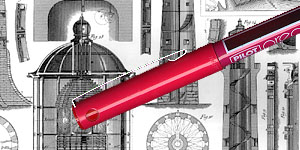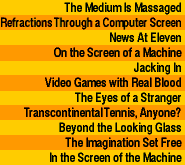


News At Eleven
When computers make it cheap enough for us to generate any seemingly live-action scene we wish, we may have news programs consisting solely of simulated scenes. We already have dramatic reenactments of reported events on television, and massive amounts of computer graphics and image massaging in advertising. Considering the artificiality of television commercials today, we're already well on the way to artificial news. It's inevitable that someone somewhere will use that technology for propaganda.Today's television sets have knobs to control their displays in primitive ways: color, brightness, contrast, and so on. But if television begins to show artificial news, perhaps we could also have a reality knob to change the realism of the scenes we view. If so, then how about a drugs, sex, and violence knob? Or a political-bias knob?
What works for television sets can also work for telephones. Today, if you want to change your telephone voice because you don't want strangers to know you're female, you can buy a device to do so. Tomorrow, you may want to change your voice to make yourself sound ill when pleading sickness to your boss. Eventually, voicephones will turn into videophones. Then we'll start shopping around for cosmetic software to manipulate our images second-by-second. Being conveniently ill will always have advantages.
Eventually, we may not believe anything we see or hear on a screen, a phone, or a page. Then, perhaps, the government will mandate that the news must be real. Or perhaps not. Maybe we'll prefer our news simulated, because it looks and sounds so much better than the real thing.
All of this isn't new, of course. We've been doctoring movies for as long as we've had movies to doctor. For example, many First and Second World War newsreels were either staged or faked outright. And the faking goes back at least as far as the turn of the century; many newsreels of the Boer War were shot in Jersey instead of South Africa, where the war actually took place. Even then filmmakers knew that faked action looks much more real than the real thing. In a real war, too much happens too fast for even military viewers to make much sense of it. Further, soldiers make bad actors. They have an annoying habit of fighting when it's too dark to shoot good pictures; they persist in not clumping into nice, neat bunches during attacks; and they either die too messily for stay-at-home viewers or they don't die dramatically enough.
Of course, all that changed when the Vietnam War came along, and a camera shrank enough for one person to carry and use one. Everyone could finally see exactly what war looked like, right there in the living room. Then came the 1991 Gulf War. And as the phosphorescent tracer rounds lit up the night-scoped Baghdad sky, real war became even more pyrotechnic than film war. At least for a while.
"Seeing is believing," we used to say; but that's never really been true. During the Second World War, newsreels showed Hitler dancing a jig after the fall of France in 1940. Hitler was many things, but a jig fancier he wasn't. He never did dance that jig---he just lifted his leg. It was Allied newsmakers who optically looped that leg movement into a jig. Perhaps one day governments will use computer simulations in a similar way to keep deranged or dead political leaders in power for twenty years, looking younger every day. Then we'll all be jigging to the beat.